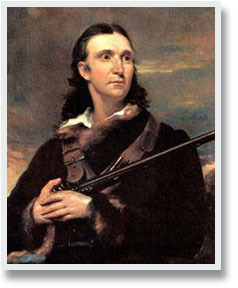John James Audubon (1785-1851)

Audubon was born in 1785 in Haiti, then a French colony known as Saint Domingue. His father was the owner of a sugar plantation, on which the majority of labour was done by enslaved people from West Africa. Audubon's mother was not married to his father, and she died shortly after Audubon's birth. Audubon moved to France at a young age, where he was raised by a stepmother who encouraged his love of drawing and nature.
In 1803, Audubon was sent from France to Philadelphia so he would not be conscripted to fight in the Napoleonic wars. He spent some years on a farm near Philadelphia, where nine enslaved people worked for him, whose forced labour gave Audubon the freedom and money to pursue his passions: hunting, studying and painting birds.
Working as a trader and a business man, Audubon explored Eastern and Central North America. Along the way he collected and painted a huge variety of birds for his most famous publication, The Birds of America, published in 1827-1839. The Birds of America aimed to illustrate every American bird species, depicting even the largest birds in life-sized proportions, and was printed in parts on 'double-elephant' paper which is almost 40 inches wide by 30 inches tall.
Between 1826-1838 Audubon came to Britain to find an engraver capable of meeting his high standards. He spent a total of three years in Edinburgh, where he met and worked with the great Scottish ornithologist William MacGillivray. They became great friends and MacGillivray is credited with much of the scientific content in the extensive texts that accompanied Audubon's superb illustrations. When MacGillivray was appointed to the Chair of Civil and Natural History at Marischal College in 1841, he brought to Aberdeen many items he had been given by Audubon. Most of this material has only come to light in the past few years.

Autographic notes of William MacGillivray, chiefly on British birds, 1836-40
The University collections holds a copy of volume 2 of The Birds of America, covering parts 21-40, plates 100-200. The history of this volume is unknown. There is a full set of Audubon's Ornithological Biography.(1831-1849; SB 5982(73) Aud) and the separately published text which accompanies the plates, which MacGillivray helped to prepare.
Journals and notes by William MacGillivray are also held in the University collections. In this excerpt from one of MacGillivray’s journals, a chapter entitled “The Two Ornithologists”, he discusses his relationship with James Audubon.
Yellow-throated Vireo skin prepared by Audubon and presented to MacGillivray, RN 26,959
One of 12 bird skins given by Audubon to MacGillivray. For further information on the discovery of these skins, look here.
Polygala Pubescens, North America
This is one of nearly 70 herbarium sheets given by Audubon to MacGillivray. They were collected by Miss Bachman, a relation of the Rev John Bachman, another of the American natural history greats. The Rev John Bachman collaborated with Audubon to produce a sister work on mammals, The Quadrupeds of North America (1846-1854). The two families were very close for many years, and two of Bachman's daughters married Audubon's sons, though both died young.
Human Skulls
Audubon both benefitted from and perpetuated the injustices of white supremacy and colonialism. He opposed the abolition of the transatlantic slave trade, and himself held people in slavery. Some of his scientific work promoted racist ideas.
Audubon was interested in phrenology, the pseudoscientific study of human skulls to reveal mental traits that was used to justify racist and white supremacist beliefs. Audubon stole the remains of Native American people from burial sites in pursuit of this interest, some of which he sent to MacGillivray for the University of Aberdeen's collections. Some skulls previously housed in the Anatomy Museum were identified in 2009 as being those sent by Audubon to MacGillivray. It is now the University's responsibility to address this legacy, including repatriating the remains of ancestors.
See https://www.audubon.org/news/the-myth-john-james-audubon for recent research into Audubon’s racial legacy.


![[Untitled] [Untitled]](https://exhibitions.abdn.ac.uk/university-collections/files/fullsize/75ff0b2f86dce5f0e0292747df67f38e.jpg)
![[Untitled] [Untitled]](https://exhibitions.abdn.ac.uk/university-collections/files/fullsize/4b97424a36be1e49295d70667f5d8cd2.jpg)
![[Untitled] [Untitled]](https://exhibitions.abdn.ac.uk/university-collections/files/fullsize/f1cfce21ef0cd9f75306a3e515fd9eb2.jpg)